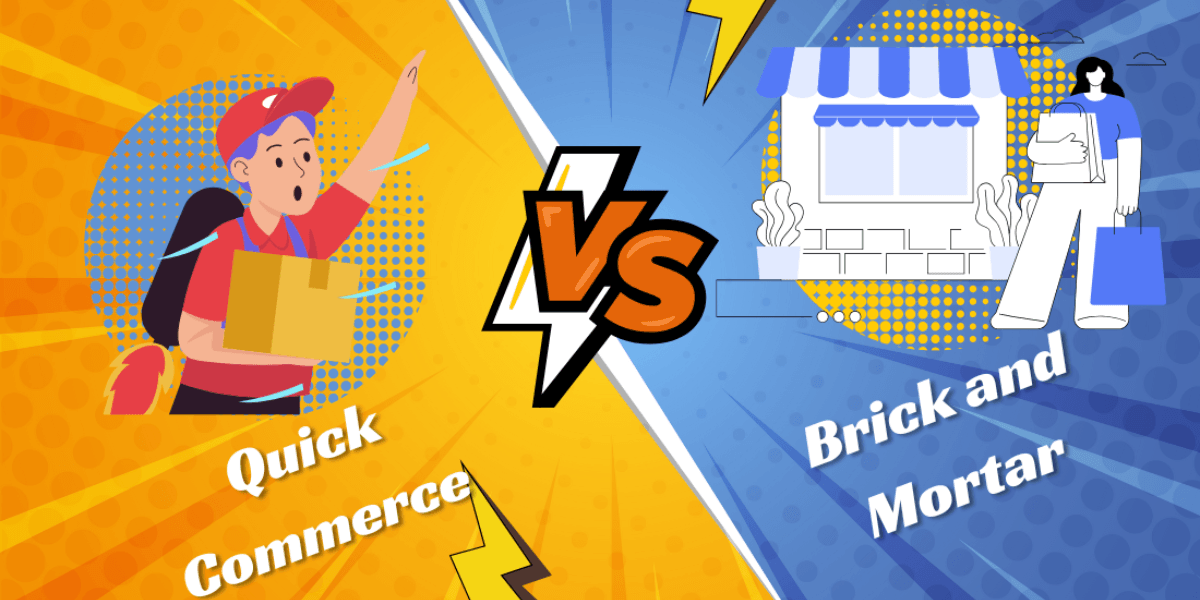Quick Commerce vs Brick and Mortar: The Battle for Retail Supremacy

The retail sector is rapidly evolving and so is the competition among the two. Quick commerce and brick-and-mortar stores are shaping the future of consumer experiences by offering the best of their services. Traditional brick-and-mortar stores are well known for their tangibility and immediacy. Helps customers like us to get a range of goods, mostly under one roof.
Whereas, quick commerce brings unbeaten convenience. Where consumers can get their products delivered on the same day within hours or with some goods; you can get them within a few minutes. These two models (quick commerce vs. brick-and-mortar store) are in a battle to survive and grow. Consumer preferences are changing rapidly and most people want technological innovation to make their lives easy.
Especially post-pandemic, people with hectic lifestyles choose quick commerce over brick-and-mortar stores. Retailers that understand the advantages and challenges of both models turn towards a well-rounded omnichannel strategy.

Quick Commerce: Speed and Convenience
Quick commerce is also a form of e-commerce where consumers get super-fast delivery (often within minutes). {Read e-commerce vs quick commerce also)
This is specially designed to cater to people with time constraints. This model was first established in metro cities in India around 2002 with the rise of Blink it, Swiggy, or Zepto. But these companies are expanding in smaller cities now as well.
Last two years, India has seen massive growth in the quick commerce industry. The sales through this model increased by more than 280%. Quick commerce is expanding way faster than traditional e-commerce, because of its speedy delivery services.
Brick and Mortar: Tangibility and Experience
While quick commerce has taken over the market with the storm, brick-and-mortar stores are still in people’s hearts. Online stores can't give the satisfaction of touching, seeing, or feeling the goods before buying. In-store or physical store experiences are something many customers crave especially after a long lockdown.
Advantages of Quick Commerce over Brick and Mortar Store:
- Faster Delivery: Quick commerce's primary benefit is to make express delivery, often within minutes.
- Convenience: Customers can order from anywhere, at any time (if the app serves there).
- Less Physical Effort: No physical visit to stores is required.
- Increased Accessibility: Customers can access the products without having to step out.
- Wide Product Range: Quick commerce platforms also offer a wide range of goods.
- Real-time Tracking: Consumers can track their orders after placing orders.
Drawback of Quick Commerce:
- Delivery Costs: Inflated delivery costs, especially for small orders and in peak hours.
- Limited Product Experience: Customers have no interactions with products before buying.
- Quality Concerns: Quality cannot be accessed on screens.
- Return and Refund Issues: Return and refund processes are complicated.
- Dependence on Technology: Cannot buy products without the internet or digital payment systems.
- Customer Service Limitations: Minimal to no customer support.
- Environmental Impact: More carbon footprint due to excess packaging and rapid delivery.
Benefits of Brick and Mortar over Quick Commerce:
- Physical Experience: Customers can try, touch, feel, and experience goods.
- Personalized Service: Face-to-face interaction with a salesperson.
- Immediate Satisfaction: Customers feel the joy of owning and receiving the products immediately.
- No Delivery Costs: No extra payment for home/location delivery.
- Returns and Refunds: Easy return and refund affair.
- Building Brand Loyalty: Physical stores can easily promote and establish brand loyalty.
Disadvantages of Brick and Mortar:
- Geographical Limitations: Customers living far away think twice before visiting stores because of distance, weather, and time it takes.
- Time-Consuming: Physical stores require you to step down and be at the place for shopping.
- Limited Product Range: If the store has limited space, you’ll get limited items.
- Higher Operational Costs: Rent, staffing, electricity, wifi, and other maintenance expenses.
- Limited Hours: Stores generally shut down at night.
- Parking and Accessibility Issues: Stores in narrow lanes have difficulty finding parking.
- Inventory Management: Difficult to manage all kinds of inventory in one place.
Quick Commerce or Brick and Mortar Store: What One To Choose?

Even today, quick commerce and traditional physical stores are standing against each other. And competing to take more space in the market, but to benefit both the sectors. Both models must work together. Consumers will always choose quick commerce when in a hurry or they do not have the privilege of going out to get their products.
Meanwhile, brick-and-mortar stores must continue to offer unique, personalized experiences to their customers but online can never replicate it. As active users of both models, it's difficult to choose one because both the approaches have pros and cons and consumers turn to each model when it's feasible for them.
So, for customers, it is not quick commerce vs brick and mortar store but it is quick commerce and brick and mortar, as per convenience.
Conclusion
It’s 2024, and the customers do not mind the method but how great their experience is while buying a product. So, retailers must find a balanced approach that takes into account the strengths of both channels to create an omnichannel experience for consumers. Brands that jump into the market with integrated speed and convenience of quick commerce with brick-and-mortar experience will grow fast in the retail landscape.
Read more gd-topics to stay updated:
https://mbaroi.in/blog/clicks-vs-bricks/